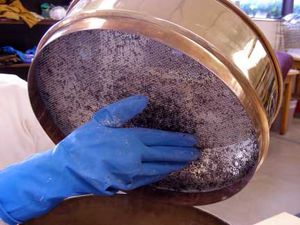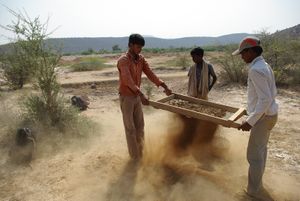Sieving
Sieving is a simple and convenient technique of separating particles of different sizes. A small sieve such as that used for sifting flour has very small holes which allow only very fine flour particles to pass through. The coarse particles are retained in the sieve or are broken up by grinding against the screen windows. Depending upon the types of particles to be separated, sieves with different types of holes are used. It is also used to separate stones from sand.
Mechanical vibratory sieving
Mechanical vibratory sieving also commonly referred to as gyratory separators or screening machines, are a traditional part of processing dry bulk powders. They classify materials by separating them by particle size through a screen mesh. Using a combination of horizontal and vertical movements by means of a vibratory motor, they spread the material over a screen in controlled flow patterns and stratify the product. There are three main functions a vibratory sieve or separator can achieve:
- Check/safety screening: used for quality assurance by checking for foreign contaminants and oversized material and removing them from the product.
- Grading/sizing screening: used to grade or classify material into different particle sizes.
- Recovery screening: used to recover valuable materials in the waste stream for re-use.
Most machines vibrate at 1400 rpm, but by separating the motor from the rubber suspension in this type of design, it became possible to increase the operating speed of the machines up to 2800 rpm with high out-of-balance forces. This development led to increased efficiency of the sieve, enabling smaller diameter machines to be used without adversely affecting performance.
Types of sieves used in cooking
- Chinoise, or conical sieve used as a strainer, also sometimes used like a food mill
- Cocktail strainer, a bar accessory
- Colander, a bowl-shaped sieve used as a strainer in cooking
- Flour sifter, used in baking
- Mesh strainer, or just strainer, usually consisting of a fine metal mesh screen on a metal frame
- Spider, used in Chinese cooking
- Tamis, also known as a drum sieve
- Tea strainer, specifically intended for use when making tea
- Zaru, or bamboo sieve, used in Japanese cooking
Hockey
At many college and high school hockey games, fans refer to the visiting goalie as "sieve". This is a reference to the holes in sieves and implies that the goalie cannot stop the puck from entering the net. Don Cherry famously dubbed Colorado Rockies' goalie Hardy Åström the Swedish Sieve.

